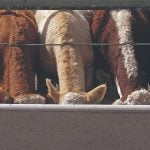There were no sales during the the week ending January 6, but that didn’t stop the phone calls or coffee shop chatter about the cattle market. The holiday break for the cattle market is analogous to an the intermission between periods of hockey game. Feedlot operators assess inventory and to focus on the market structure. They’re planning their purchase strategy for the next couple months.
Cow calf producers enjoyed historically high prices this past fall. While some operators are using this market opportunity to exit the business, other producers are working on expansion plans and risk management strategies if there is another drought his summer. There are a number of factors that cow calf producers need to be aware of in 2024.
Read Also

U.S. livestock: Feeder cattle hit contract highs on tight supply
Chicago | Reuters – All Chicago Mercantile Exchange feeder cattle futures and most live cattle futures hit contract highs on…
Feedlot margins on unhedged cattle are deep in red ink. Fed cattle prices in Southern Alberta fob feedlot were quoted at $215-$218/cwt last week. Break-even pen closeout values are at $245/cwt. During the fall period, feedlot operators and custom feeders buy cattle regardless of the fed cattle outlook for the spring and summer. During January and February, pencils are sharper and feedlot operators tend to be prudent with replacement purchases. During December, higher quality 800-pound steer calves were trading in the range of $300-$310/cwt and backgrounded 850-pound steers were $280-$290/cwt. This market will have a softer tone during January and February. Currently, cattle coming into the feedyard have a $250 bill attached to them.
Past history tells us that cow calf producers need one year of historical high prices before expansion occurs. The industry is expecting significant heifer retention south of the border while in Canada, the producers expanding will likely be offset with those exiting the business. U.S. feeder cattle supplies will be historically tight resulting in stronger export demand for Western Canadian feeder cattle. Western Canadian grass conditions for the spring and summer are uncertain. Hay and straw prices remain elevated in Western Canada and the trend in weather is above average temperatures and below average precipitation. This will also influence expansion plans. Keep in mind the grain trade is expecting a year-over-year decline in U.S. corn and Canadian barley acres. Feedlot operators are expecting stronger feed grain prices this fall.
Feeder cattle weighing 700-800 pounds have a mixed outlook. Some of these cattle will still go on grass but the feedlot sector will be on the defensive. Feeder cattle under 700 pounds will likely remain firm. These cattle are optimal for grass and even if they move into the feedlot, the fed cattle outlook for the third and fourth quarters of 2024 is extremely bright. The risk reward for the feedlot operator favors ownership of the lighter calves. Yearling prices this fall will rival last year so major operators don’t want be caught off guard paying astronomical prices for yearlings.
–updated Jan. 10, edited for clarity.
— Jerry Klassen is president and founder of Resilient Capital, specializing in proprietary commodity futures trading and market analysis. Jerry consults with feedlots on risk management and writes a weekly cattle market commentary. He can be reached at 204-504-8339 or via his website at ResilCapital.com.















